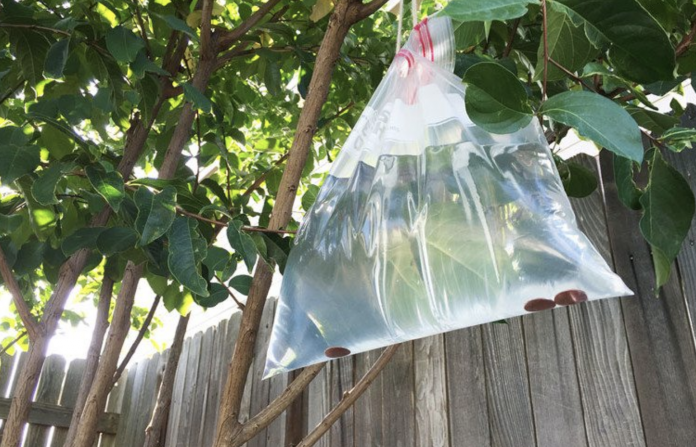In the realm of pest control, where chemical-laden solutions often dominate the landscape, an unassuming yet remarkably effective method has quietly persisted for generations – the use of water-filled bags to repel flies. These translucent bags, filled to the brim with ordinary tap water, defy conventional wisdom by offering a natural and eco-friendly solution to a common nuisance.
While the practice may seem peculiar at first glance, its effectiveness lies in the intricate interplay of light, reflection, and the innate instincts of these pesky insects. In this exploration, we delve deeper into the science behind this age-old technique, unraveling its mysteries and uncovering practical insights into its application for creating fly-free environments around homes and outdoor spaces.
Understanding the Fly’s Perception: To comprehend why water-filled bags are effective in repelling flies, it’s essential to delve into the sensory world of these tiny insects. Flies, like many other creatures, rely heavily on visual cues to navigate their surroundings and assess potential threats. Their compound eyes, though not as sophisticated as those of certain predators, are finely attuned to detect movement and changes in light patterns. When confronted with a water-filled bag, flies perceive a distorted reflection caused by the rippling water within. To their simple yet discerning eyes, this distortion resembles the movement of a predator or a looming danger, triggering an innate fear response.
The Role of Light and Reflection: Light plays a crucial role in the effectiveness of water-filled bags as fly repellents. Sunlight, in particular, acts as a catalyst, intensifying the visual illusion created by the moving water. As sunlight penetrates the translucent plastic of the bag, it refracts and disperses within, casting shimmering patterns and reflections on the surface. These dynamic visual cues, coupled with the distortion caused by the water’s movement, amplify the perceived threat level in the eyes of the flies. The result is a convincing illusion of an impending danger, compelling flies to avoid the vicinity and seek safer havens elsewhere.
Optimizing the Repellent Effect: While the basic premise of using water-filled bags to repel flies is simple, certain nuances can enhance its efficacy. One key factor is the level of water agitation within the bag. For optimal results, the water should be filled to approximately two-thirds of the bag’s capacity, allowing ample room for movement without causing excessive splashing or leakage. Gentle tapping or agitation of the bag helps initiate the desired effect, creating subtle ripples that enhance the illusion of movement. Additionally, some practitioners take it a step further by adding a few shiny coins or reflective objects to the water. These additions serve to amplify the reflective properties of the bag, intensifying the perceived threat level for flies.
The Eco-Friendly Advantage: In an era where environmental sustainability is paramount, the use of water-filled bags as fly repellents holds distinct advantages over chemical-based alternatives. Unlike synthetic pesticides or insecticides, which can pose risks to human health and the environment, water-filled bags offer a safe and non-toxic solution. They require no harmful chemicals or additives, relying solely on the principles of light and reflection to achieve their intended purpose. This eco-friendly approach not only minimizes the ecological footprint but also aligns with the growing preference for natural and sustainable pest control methods.
Practical Applications and Considerations: The versatility of water-filled bags makes them suitable for a wide range of applications, from residential homes to commercial establishments and outdoor venues. They can be hung or strategically placed in areas prone to fly infestations, such as outdoor dining spaces, patios, or near garbage bins.
Additionally, they are cost-effective and easy to implement, requiring minimal maintenance or upkeep. However, it’s important to note that while water-filled bags are effective in repelling flies, they may not offer complete eradication of the pests. Combining this method with other integrated pest management strategies, such as proper sanitation and exclusion measures, can yield more comprehensive results.
Conclusion:
In the realm of pest control, simplicity often belies effectiveness, and the practice of using water-filled bags to repel flies stands as a testament to this principle. By harnessing the power of light, reflection, and innate insect behavior, this age-old technique offers a natural and sustainable solution to a common nuisance. As awareness grows regarding the environmental impact of conventional pest control methods, water-filled bags emerge as a beacon of eco-friendly innovation.
So, the next time you encounter a seemingly strange sight—a plastic bag filled with water hanging in a doorway or on a porch—pause to appreciate the ingenuity behind this humble yet effective fly repellent. In a world where solutions often come at the cost of environmental harm, embracing nature’s own trickery may just be the key to achieving harmony between humans and the pests that share our spaces.
Source of the picture : wide open country










